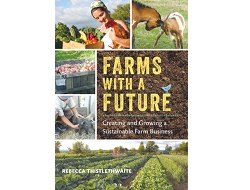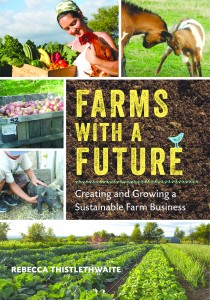
 Farms With a Future; Creating and Growing a Sustainable Farm Business, by Rebecca Thistlethwaite, foreword by Richard Wiswall, published by Chelsea Green in White River Junction, Vermont, 2013; paperback, 336 pages, $29.95.
Farms With a Future; Creating and Growing a Sustainable Farm Business, by Rebecca Thistlethwaite, foreword by Richard Wiswall, published by Chelsea Green in White River Junction, Vermont, 2013; paperback, 336 pages, $29.95.
Reviewed by Bethany M. Dunbar
Rebecca Thistlethwaite has put together one of the most useful and entertaining books about farming I’ve read in a long time. Everyone who dreams of starting a small farm needs to check this book out.
The author is not modest about her intentions:
“This book is about creating a new paradigm for doing business, one that will last into the future, taking care of both our planet and all of our inhabitants (human or otherwise),” Ms. Thistlethwaite declares at one point. That comment came on page 226. If it was on the first page, I might have stopped reading. But by page 226 I knew that it was an accurate statement, and that her efforts could and probably actually will bear fruit.
With the local food movement in full swing around here, there are all kinds of people hoping to get involved and seeing farming as a romantic lifestyle. If you know anyone with those feelings, urge them to read Ms. Thistlethwaite’s book before they get in too deep. She includes information on bookkeeping, marketing, pricing strategies, building up the soil, employees, working with family members, and many other practical matters often neglected at first.
“I don’t want you growing or raising a single thing until you have some concept for where you will sell it, to whom, for how much, and who your potential competition might be,” she writes.
But if the book was only a “how-to” I might have become bored after a few pages. Instead, the book was written by a woman who has farmed herself and decided to take a year off those endeavors to travel around the United States and interview some of the most successful farmers out there about their ideas and methods. These stories will be of interest to anyone with an entrepreneurial spirit, not just aspiring farmers.
Butterworks Farm in Westfield, the Lazor family, is one of the farms she has profiled. In a chapter called, “Scaling up while keeping true,” Ms. Thistlethwaite tells their story.
“What first started out as a homestead for this couple of back-to-the-landers has turned into one of the most successful organic farmstead creameries in the nation,” she writes. They bought their 60-acre farm in 1976 for $20,000. It was money Anne Lazor’s parents’ had saved for her to attend graduate school. Instead it was their initial investment, and Butterworks Farm has grown from there.
Jack Lazor has written his own book, and on Sunday in Newport from 1 to 3 p.m. at the Gateway Center his new book, The Organic Grain Grower, also published by Chelsea Green, will make its debut. Eliot Coleman, an organic farmer and writer from Maine, and Brent Beidler, president of the Northern Grain Growers Association, will be on hand for the event. Mr. Coleman wrote a foreword for Mr. Lazor’s book.
Butterworks is one of 15 case studies of farms across the nation in Ms. Thistlethwaite’s book. She interviewed the farmers featured in case studies and a half dozen others — people who are growing and selling everything from soup to nuts.
The book is packed with ideas for creative financing, marketing, and production. It’s an encouraging book for those in the right frame of mind. Those who just want to buy land and shiny tractors won’t like this book. But those who really want to build a farm that can keep going will be glad of all the advice and ideas.
Some farmers might read it and weep, at least at first. For example, Ms. Thistlethwaite tells of a chicken farmer who paid an employee to water the chickens without considering the cost of hiring that help versus buying an automatic waterer.
“Oblivious to this information, he will continue to spend around $11,000 a year on labor costs for watering (his employee is paid $15 an hour). An automatic system would be just a fraction of that cost and last him for many years to come. This particular farmer is not currently profitable and is always on the verge of throwing in the towel. He could be putting $11,000 in his pocket each year, which might turn his business around for good.”
Ms. Thistlethwaite’s take-away advice: “Find out what a typical enterprise budget looks like for the crops and animals you produce. If your income or expenses look dramatically different than those budgets, do some research to find out why they vary so much. It may be that some of your expenses are way beyond the norm.”
If you as a farmer don’t like bookkeeping or can’t afford to hire a bookkeeper, maybe you can trade food for services, she suggests. The potential for barter is a common theme in Farms With a Future.
“USDA Economic Research Service report estimated local food sales totaled $4.8-billion in 2008 (direct to consumers or direct to restaurants/retailers), and the report predicted that figure would reach $7-billion in 2011. Because of the nature of data limitations, it is more likely that local food sales, including the value of barter and trade, have a much higher economic value than this and are continuing to grow by leaps and bounds.”
Farms included in Ms. Thistlethwaite’s case studies include Shady Grove Ranch in Jefferson, Texas. It’s the story of a young couple, Matt and Jerica Cadman, who were studying engineering and came to agriculture through health issues that led them to find better food.
“Matt was diagnosed with ulcerative colitis, an ‘incurable’ inflammatory bowel disease,” she writes. The couple spent two years battling the illness with conventional methods, including hospitalization and drugs, and doctors suggested that at age 22, Matt should have his colon removed.
“In their research on alternative therapies, the demise of vitamins, minerals, and health fats in the American diet became apparent. The Cadmans started adding grassfed beef, pastured poultry and eggs, and raw milk to their diet, but had to drive all over the state to acquire these products, which were hard to find in East Texas. By creating their own farm, they were able to get Matt healthy and provide healthier food for people around them.
Ms. Thistlethwaite is clearly devoted to organic and old-fashioned methods, but she urges new farmers to seek help and advice from conventional farmers as well:
“You can glean good information from even the big guys, so don’t write them off just because they are conventional. With their years of experience, chances are they know more about your animals than you do,” she writes.
Matt and Jerica Cadman have something in common with another couple Ms. Thistlethwaite interviewed, Jennifer Argraves and Louis Sukovaty of Crown S. Ranch in Winthrop, Washington — an engineering background. Both spent ten years working as engineers in Seattle before deciding to start a farm. Their research led them to read pre-World War II agricultural research about farming methods before chemicals and nitrogen fertilizers were so heavily used.
Not all farmers have a background in engineering, but this couple came up with an idea that would have been labeled Yankee ingenuity if someone in New England first thought of it: a solar-powered chicken tractor which drags broiler hens slowly over pasture land.
“A solar panel mounted on the chicken tractor slowly charges the battery, which runs a small motor that moves a set of wheels. This moves the chicken tractor in small increments, about four inches every half hour, so that the broiler chickens inside can always have access to fresh pasture.”
Farms With a Future is full of this kind of idea. My only complaint about the book is that in all its discussion of marketing and getting to know your consumers, and so much emphasis on the web and social media, it barely mentions local newspapers as a good way to draw new customers and bring the old ones back every week. I know what you are thinking — I’m biased. But the fact is, print media works. Neglecting it means losing out on new business, and current customers might forget to come back. So my two cents here is this: don’t forget your local newspapers when you think about how to sell your local food.
Congratulations to Rebecca Thistlethwaite and thanks — for writing a book that will be useful for lots of people. It could help some farmers get started, help others to decide they don’t want to invest a lot of money in a difficult enterprise, and help someone struggling to figure out ways to turn his or her business around.
contact Bethany M. Dunbar at [email protected]
For more free articles from the Chronicle like this one, see our Reviews pages. For all the Chronicle’s stories, pick up a print copy or subscribe, either for print or digital editions.







